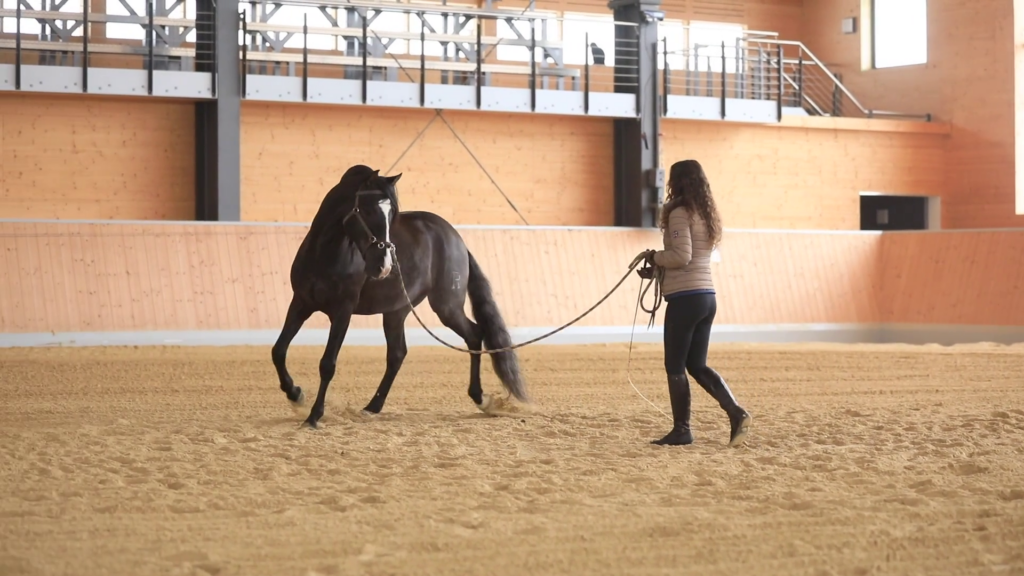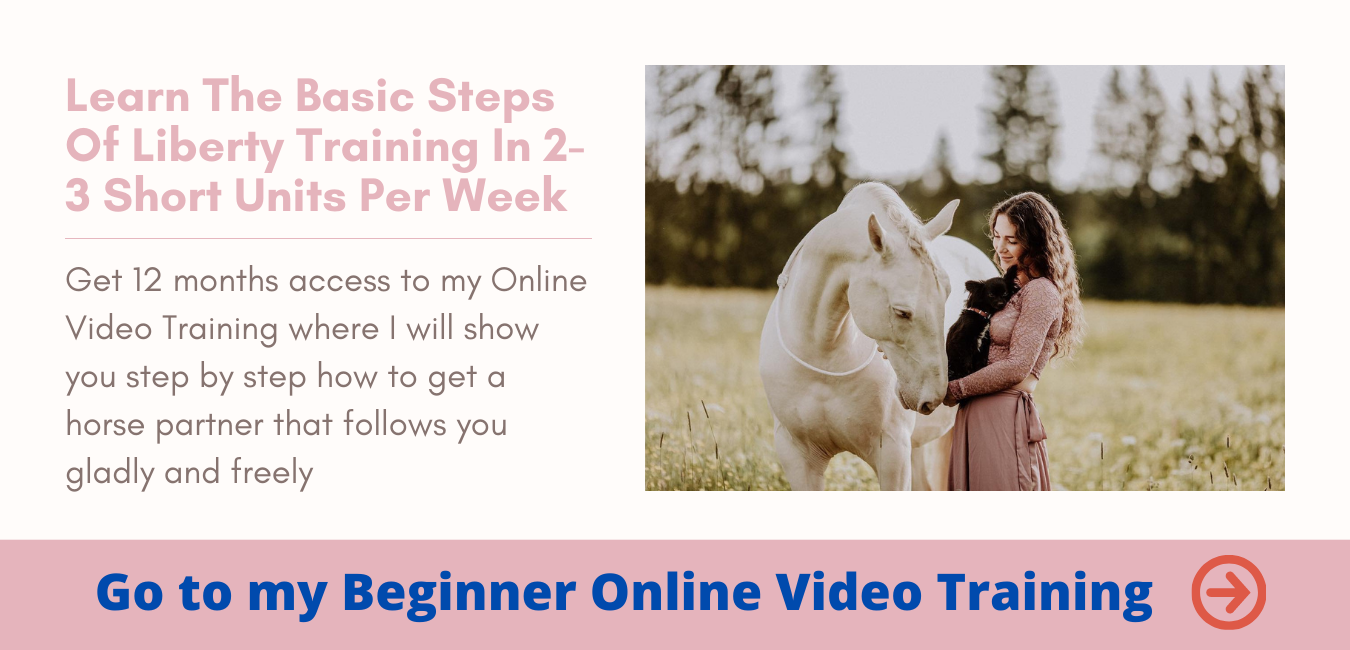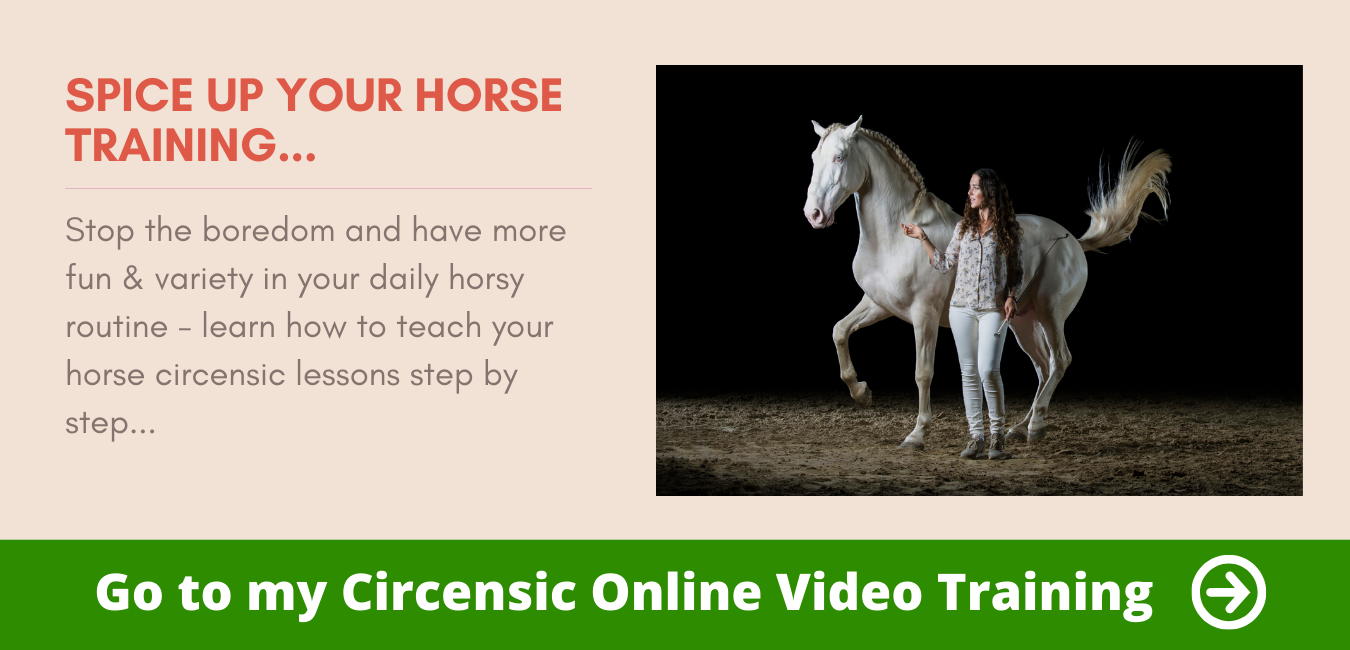Since we have made a small excursion into gymnastics on the lunge line and in the hand in the last two blog posts, you may be asking yourself:
Where does that bring us to liberty work?
In fact, I find that lunging is the optimal preparation for circling in the direction of liberty work.
If your horse feels comfortable on the big circle and can move in a balanced way, then the small circle will be much easier for him.
This does not mean that you should not practise liberty dressage as long as your horse does not walk perfectly.
Because there is no such thing as “perfect” in connection with living beings – regardless of whether it is you as a trainer or your horse.
Nobody is perfect!
But we should all have the ambition to make our horses a little healthier. But muscles and balance are only trained if you also push your horse to its “limits” again and again.
Training for body and mind?
Let’s take a quick look at when a muscle starts to grow: because the muscle only grows when it has been overstrained with a load. This is actually a protective mechanism of the body.
So now the muscle grows in order to be prepared for the next load.
For us, this actually means that we should try to train as much “positive muscle growth impulses” as possible.
Nevertheless, allow your horse to develop and experience his body feeling himself and do not permanently “pull on him”.
In the end, good impulses do not depend on a certain shape and it is of little help to you and your horse if you try to force him into a certain shape (example: head down does not necessarily mean back up!).
Stay dynamic and look and feel carefully, then nothing can really go wrong?
But now back to the topic of lunging vs. circling.
The only difference is not only the size of the circle. It is mainly in the long-term intention!
The aim of lunging is to train the horse’s body in the most gymnastic way possible.
Of course I use impulses on the lunge (e.g. in connection with the voice signal for “head down”) and my whip to get the shoulder up or to encourage the hindquarters to go under.
Circulation, on the other hand, is not so much about the body, but mainly about the horse’s mind.
We want real communication and try to gradually reduce any aids – apart from our body.
Because only in this way will you and your horse become truly free.
This does not mean that we do “more” when circling – we can even reduce our body language to an almost invisible minimum – the goal is probably just different.
That’s why we always have to question every help, every gesture and every signal to see if it would still work freely and without a rope.
And whether we have also built up a real connection with our horse that will later keep him free with us. Even if it gets exhausting!
This is how it works: The circling
When I want to start circling, I usually start on the left hand – with the horse on our right side.
I don’t change my position at all – I just move out of the lead and onto a circle.
If your horse is already well balanced, you can start directly on a smaller circle, if your horse is not yet so well trained, you should choose a larger circle line.
[su_youtube url=”https://youtu.be/7bpk1V-eZO4″]
The horse should now also hold its “feel-good” position on the circle line: With his head slightly in front of my shoulder, but his shoulder definitely behind my shoulder.
If you have already practised this position intensively when leading, your horse will quickly understand that these rules simply continue to apply.
Now use your body in a very direct way – also in connection with your voice signals.
Be careful not to pull on the rope, because we would like to leave that out in the future.
However, it is best not to let your horse free right from the start, because he first has to learn to react to your signals in the way you want him to.
If it gains the experience that it can simply run away to avoid the situation, the road to free work will only become longer and stonier.
Because the impulse to run away will occur much less often once your horse has understood (also with the help of the rope) what you want from him.
This means that you have to pay close attention to where your shoe tips and shoulders are pointing.
You just want your horse to walk in a circle?
Then make sure that your inner shoulder is always a little further back than your outer shoulder.
If you turn towards your horse, you are visually “closing the door” on him and telling him to slow down or even stop.
Also, your toes should always point in the direction you want your horse to move. Also make sure to approach your horse with the right energy.
Do you want your horse to go faster?
Give the voice command to trot and at the same time bring tension into your body. Breathe in, straighten up and, if necessary, do another “trotting step”.
But don’t do too much, because too much presence and tension often cause you to send your horse away from you – because you also straighten up, but you also move towards your horse and send the forehand or hindquarters or the whole horse away from you with your eyes.
You now want to parry through again?
Take the tension out of your body, give the voice signal and breathe out.
You can now also bring your inner shoulder forward and visually close the door for your horse.
If you also want to bring the horse towards you, make yourself a little smaller and take a few steps backwards to “pull” the horse towards you.
You can also send the forehand and hindquarters away from you using your body alone. If you want to move the hindquarters, use your inner shoulder, which you have turned forward, to visually close the way forward again.
Then look at the hindquarters, move towards them and if necessary touch the hindquarters with your crop as an extended arm.
You can also let the shoulder move away from you in this way: You touch the shoulder with your hand or the whip while standing at a 90° angle with your own shoulders to the horse’s shoulders.
Now “push” the horse’s shoulder away with your body. Please only in the figurative sense! If you engage in real “pushing”, your horse will certainly react to the pressure with counter-pressure. Impulses are always better here – and play with your energy!
Every horse needs a different intensity – and that’s what you have to find out.
You can see that when circling on the left hand, your position and body posture is completely different than when lunging.
On the right hand it looks different again. But how to change direction well and lunge on the right hand I will explain in one of the next blog posts ?
Have fun practicing and watching your body language & energy closely!
All the love,
Your Kenzie




